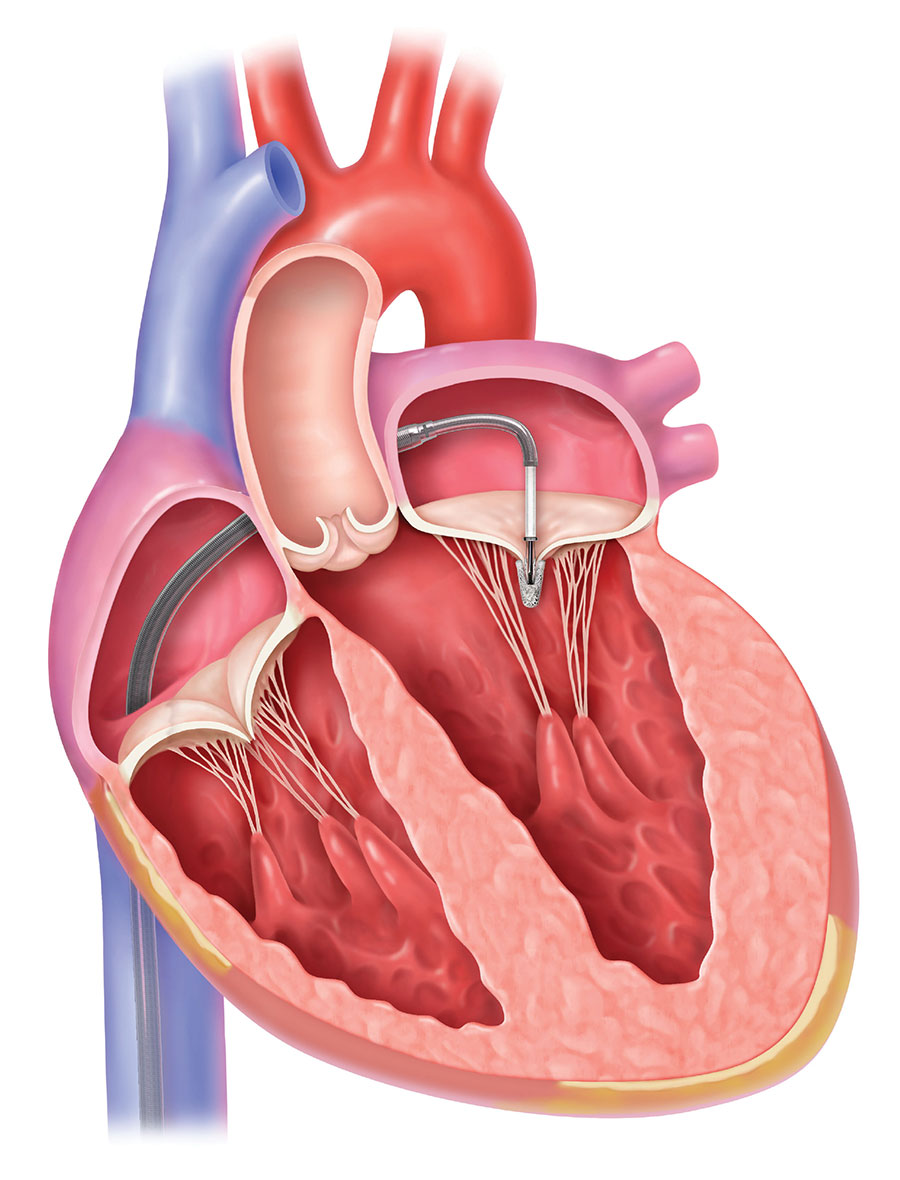Mitral valve disease can be caused by a number of factors and each person's valve may be affected differently. Some valve disease may be due to infection, rheumatic fever, heart attack, coronary artery disease or other causes. Common mitral valve diseases include:
- Mitral valve regurgitation — The mitral valve allows blood to flow from your heart’s left atrium to the left ventricle. Mitral valve regurgitation occurs when the mitral valve’s two leaflets (“flaps”) don’t close properly, causing blood to regurgitate (flow backward) into the left atrium. This causes the left ventricle of the heart to work harder and dilate (enlarge in size). The increase in heart size and strain can cause heart complications such as, atrial fibrillation and congestive heart failure.
- Mitral valve prolapse (MVP) — Mitral valve prolapse is a specific form of mitral valve regurgitation in which one or both of the two valve leaflets do not close smoothly or evenly, but bulge backward into the left atrium. The backward movement of the valve leaflet(s) results in a gap that allows blood to regurgitate into the left atrium. When severe regurgitation occurs, treatment may be required.
- Mitral valve stenosis — In mitral stenosis, the opening of the mitral valve narrows and makes it difficult for blood to flow into the left ventricle. The resistance to blood flow results in increased left atrial pressure and size, which in turn can result in abnormal heart rhythms (arrhythmia), fluid in the lungs (pulmonary edema), shortness of breath, reduced exercise capacity and/or blood clots.
Our program has the unmatched expertise to treat all types of valve disease. In fact, we often treat patients with conditions too complicated for other facilities. If it’s appropriate for you, our first choice is always a minimally invasive approach, which leaves the sternum intact. That’s our standard of care.
Medical Management
If your heart valve disease is less severe, we may prescribe medications such as diuretics and blood thinners to reduce blood pressure, remove excess fluid from the blood and lessen your heart’s work. We use evidence-based, long-term monitoring to watch your condition for any changes.
Transcatheter Mitral Valve Repair (TMVr) With MitraClip®

Post-procedure side view of the heart with the MitraClip NT device implanted. Photo Courtesy of Abbott.
This alternative is a less invasive treatment option for certain patients with mitral valve regurgitation who are at high risk or inoperable for open heart surgery. During a TMVr, the MitraClip device is guided within a catheter up a vein in the patients leg to the heart. The MitraClip device, which is smaller than the size of a dime, is then positioned to join or clip together a portion of the leaking mitral valve leaflets, helping to restore normal blood flow through the patient’s heart.
Valve-in-Valve (VIV) and Valve-in-Ring (VIR) Mitral Valve Replacement
Over time mitral bioprosthestic valves or annuloplasty rings can fail or become dysfunctional. For these patients, our team provides transcatheter valve-in-valve or valve-in-ring replacements (TMVR). These less invasive, catheter-based options are available for patients who are at high risk for a second open surgery. During the procedure, a new transcatheter mitral valve is inserted inside the existing prosthetic valve or annuloplasty ring. These procedures, like other minimally invasive procedures, can be performed without a surgical incision and while the patient's heart is still beating, eliminating the need for the heart-lung machine. Patients often go home one to two days after the procedure.
Balloon Valvuloplasty
This transcatheter procedure is completed by using a balloon to open or widen the problem valve to help restore normal blood flow in patients. During the procedure, the physician inserts a balloon via a catheter up through a vein in the patient’s leg to the problem valve in the patient’s heart. Once in place, the balloon is inflated to open or widen the valve and restore normal blood flow. Valvuloplasty can potentially be used for all types of valve stenosis (aortic, mitral, tricuspid and pulmonic).
Traditional (Open) Valve Surgery
Underlying medical conditions, multiple heart problems and other factors may mean you will do better with a traditional, open procedure for mitral valve repair or replacement. Our team of physicians will work with you to determine the best treatment approach for your particular condition.
Virtual Visits Are Available
Safe and convenient virtual visits by video let you get the care you need via a mobile device, tablet or computer wherever you are. We'll assess your condition and develop a treatment plan right away. To schedule a virtual visit, call 414-777-7700.





